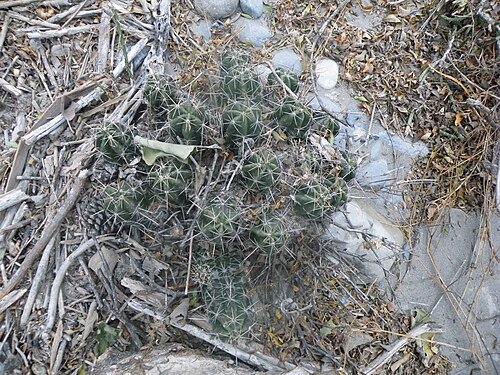Echinocereus viereckii is a species of cactus native to Mexico.[2]
Description
Echinocereus viereckii grows upright or prostrate, branching at the base. Its dull, shiny light green shoots often reach up to 20 cm (7.9 in) in length and 4 to 4.5 cm (1.6 to 1.8 in) in diameter. The apex is loosely covered with white-yellowish areole felt, topped by an upright hyaline-yellow spine. It has 8 to 9 ribs, sharply separated at the apex and running straight down, about 6 to 8 mm (0.24 to 0.31 in) high. These ribs are deeply indented between the areoles, forming mammillary-like humps. The 7 to 9 radial spines spread horizontally, are evenly distributed, and usually 5 to 7 mm (0.20 to 0.28 in) long. The 4 central spines are thickened at the base and can grow up to 2 cm (0.79 in) long.
The funnel-shaped flowers are up to 11 cm (4.3 in) in diameter and are purplish-pink, with a glassy flower tube and light golden brown thorns.[3]
Subspecies
Accepted subspecies:[2]
| Image | Scientific name | Distribution |
|---|---|---|
 |
Echinocereus viereckii subsp. morricalii (Říha) N.P.Taylor | Mexico (W. Nuevo León) |
 |
Echinocereus viereckii subsp. viereckii | Mexico (SW. Tamaulipas, Nuevo León, Coahuila) |
Distribution
Echinocereus viereckii is found in the Mexican states of Nuevo León and Tamaulipas.
-
Plants growing in Nogales, Huasteca canyon, Nuevo Leon
-
Plants growing Huasteca canyon, Nuevo Leon
Taxonomy
Erich Werdermann first described the species in 1934, and the specific epithet viereckii honors German plant collector Hans-Wilhelm Viereck.[4]
References
- ^ Guadalupe Martínez, J. (2017) [amended version of 2013 assessment]. "Echinocereus viereckii". IUCN Red List of Threatened Species. 2017: e.T152411A121623251. doi:10.2305/IUCN.UK.2017-3.RLTS.T152411A121623251.en.
- ^ a b "Echinocereus viereckii Werderm". Plants of the World Online. 2021-07-08. Retrieved 2024-06-24.
- ^ Anderson, Edward F. (2001). The Cactus Family. Portland, Or: Timber Press (OR). p. 250-251. ISBN 0-88192-498-9.
- ^ "Au Cactus Francophone". Au Cactus Francophone (in French). Retrieved 2024-06-26.
External links
 Media related to Echinocereus viereckii at Wikimedia Commons
Media related to Echinocereus viereckii at Wikimedia Commons Data related to Echinocereus viereckii at Wikispecies
Data related to Echinocereus viereckii at Wikispecies




Recent Comments